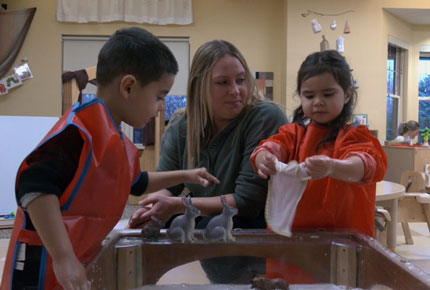Creating Environments that Build Resilience
Voiceover: Early childhood teachers need to be able to support the learning needs of all children in their classrooms, including those who have experienced traumatic events or toxic stress. But how can teachers structure their classrooms and learning experiences in ways that build children’s resilience and help them to feel safe and secure?
Creating Classroom Environments that Build Resilience (0:24)
Jason Lang, Ph.D., Vice President for Mental Health Initiatives, Child Health and Development Institute of Connecticut: The number one predictor for how a child will respond to trauma, is if there is a supportive loved one who that child feels close to who can support the child following the event.
Rebecca Parilla, Ph.D., National Clinical Director, Child First: A secure, well attuned, caregiving environment is an enormous protective factor. It offers protection and safety and security, even when there's incredible adversity facing a family that will lend to, you know, resiliency.
Bruce Perry, M.D., Ph.D., Neurosequential Model Network and the Child Trauma Academy: School and early childhood experiences are fundamentally resilience-building IF they have these three qualities: If they provide opportunities for the child to have moderate challenges—not extreme, not overwhelming, not minimal, moderate. They need to be challenged, but they need to be challenged in a moderate way. There has to be controllability of the challenge. The child has to have some sense of, “Okay, I’m done now, and I want to go back and get regulated. And I’m going to go explore. I’m going to get challenged, but I need to be able to come back and be safe.” And so, controllability, and then predictability. So if you create, in your early childhood environment, opportunities for the child to have predictable, moderate, and controllable experiences, you’ll develop resilience.
Yotisse Williams, Preschool Teacher, Early Childhood Laboratory School at Housatonic Community College: Oh, safe, predictable environment, well that really gives the kid the sense of routine. And when they know what the routine is, they feel safe. And so that is a powerful strategy, because then they know what's coming next, everything’s predictable, and you can kind of point that out, like if you have a classroom schedule. Because a lot of times in their lives, things aren't predictable. There's chaos in the home. And so by providing that safe, predictable schedule, then you have really helped a child realize that they can thrive, you know, in terms of the routine.
Bruce Perry: One of the things that we know about the stress response system is that if a child has no understanding of what’s going to happen, and they have no control over what is going to happen, they feel incredibly anxious and dysregulated. And then you give them a little bit of control and choice about what’s happening within this defined time and space. And it’s remarkable how, giving them that opportunity and an awareness of what is going on can calm them down. If, however, there are unrealistic demands and expectations that are developmentally out of sync with the child, or there’s unpredictability in the relational environment, right? So that one day the teacher’s angry about something, and the next day they’re sweet; the next day they’re neutral. That unpredictability and sort of chaotic environment is perceived by the child in a way that makes them the opposite of resilient. It makes them more sensitized, and they become less and less comfortable with novelty; they have difficulties with transitions; they don’t even want to do things that they’ve mastered before; they have more meltdowns. And so the reality is, the way you construct that environment is either going to be resilience-building, or it’s going to be sensitizing. And the goal is, of course, to create a resilience-building environment.
Rebecca Parilla: When we're able to recognize the wide spectrum of ways that young children can react to the stress in their lives, when we appreciate that, we can help build resilience, because we're really paying attention to all the different ways that kids can respond to stress and even trauma. And so having a really well-versed understanding of all those different ways that kids can react is important. And thinking of ways to support each individual child and their own individual needs is really an ideal way to build resilience across time.
Bruce Perry: One of the great things about early childhood environments is that you can provide the relationally-mediated opportunities for exploration, for practice, for leaving the comfort zone of a child while they’re learning something new in a scaffolded, protected way. And these little, sort of ventures out of your comfort zone while you’re developing, these are resilience-building. Those build resilience, so the child, the next time they’re introduced to something novel, they feel more comfortable leaving their comfort zone and mastering that feeling of discomfort that goes with being unsure.
Jason Lang: The early childhood workforce has an important role, because you're working with children at such a young age. And you're building the skills that will give children resilience for when they do have a traumatic event or if they do have a traumatic event happen down the road. And the building resilience and pro-social skills and all of those things are going to buffer the impact of trauma if it does happen later on.
Key Take-Aways (5:48)
- Early childhood settings can help build resilience in all children.
- Resilience-building experiences can buffer the impact of trauma.
- To build resilience, early childhood experiences should provide children with:
- Moderate, “just right” challenges
- Some control in how much they engage in activities
- Predictable routines and environments
© 2023 Center for Early Childhood Education at Eastern Connecticut State University.
May be reprinted for educational purposes.




